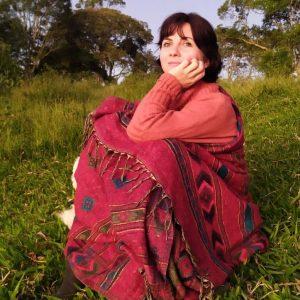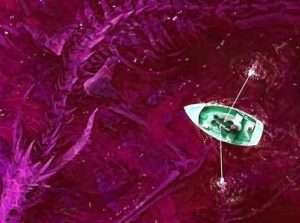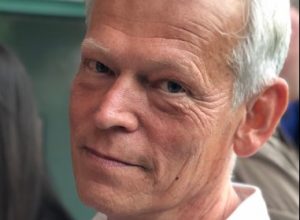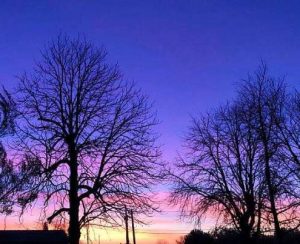
During those nights a couple of years ago, I would toss and turn a thousand times in my bed as my heart raced and then slowed so often that I almost thought it had disappeared in the unsleeping darkness. My spirit came in and out of my body as if it no longer knew its place. Three months of insomnia brought with it a feeling of being homeless.
I felt thirsty, so I got up many times to stare at the walls of the bathroom in the yellow glow of the naked bulb. I had reasons to cry, and all I wished for was to be able to sleep forever and perhaps awaken when all was over with the situations occurring in my life. But I was locked in the nightmare that was my life and any dream would have felt better. Ironically, it was during this phase that I prayed the most in my life and, somehow, I also felt closer to the gods and goddesses to whom I prayed. I felt very lonely in my room, especially during the first months of the pandemic, and so I began a habit of going outside to gaze at the moon and the stars.
I live in the Brazilian countryside, up in the hills amid the rainforest and my horses. The sky is beautiful day and night. At night it’s usually cold and I would wrap myself in a blanket and lay on a trunk bench to rest my eyes among the stars. Soon, I began talking to them, which helped me to feel less lonely. I imagined how much history they had witnessed and how every human being and maybe all beings that had ever existed over the last millions of years had at least gazed upon the landscape I was seeing now. So many times this thought replaced my thoughts of suffering and self pity. I downloaded an app that could identify the constellations and other celestial bodies, and so they had names too. After some time, I was able to identify which was a planet and which a burning star, as well as the names of some of the constellations.
More than a year passed since I adopted this habit, and I smiled at the thought that I might have found my true home: the sky. A friend reminded me that our ancestors used the sky to find their own way home, and to help them navigate across oceans and through deserts. I might have just found my own slow way home too. I started studying astrology to help identify what my life had to do with the stars’ journey through the sky. I felt that they called to me each night to teach, heal, and elevate me.
But this didn’t happen only at night. The “Astro King” also called me out of my numbness during the day to be touched by his hot and penetrating rays of light. I lay down, sometimes totally naked, to feel the rays of the sun during the morning hours. I was being touched by a star and its touch was one of love, strength, and hope. Somehow I could not trust my mind, so I trusted my body. During this intense period, my mind was unable even to read or watch a movie; sometimes I would draw or dance beneath the sky . . . but a part of me was dying, the bigger part that played most of the main roles in my life as a wife and as a mother was disrupted. Without these roles and with the world in pause and isolation, I was left instead with a big question: “Who am I?”
Now, looking back, I can see the beauty when such questions are so strong that each cell of one’s body is looking for its origin—a question pure and urgent. So we start with the universe: darkness, void, silence, stardust, sunlight, moving in orbit to ancestral rhythms. When life forces us to stop, we have an opportunity to feel this primal rhythm and to touch the raw and original self.
But it wasn’t only the sky which called me in search of my origin. Three months before the pandemic hit, which coincided with the period that my family fell apart, I underwent a small ayahuasca ritual with only friends and my mom. Besides all the colorful hallucinations and the infinite geometric images, I could also hear. Nearby me was a mango tree. I sat beneath it. A small mango fell and I heard the tree saying, “Take it.” With my teeth and my fingertips, I removed the skin and ate the mango like a wild monkey, with a delight that made me smile and laugh. Where was I all the other times I had eaten a mango yet didn’t feel that it had been made by the gods?
I looked around at all the other plants and trees. Each had a different aura; some very large, some smaller. They were also breathing and pulsating, and it soon became deeply clear that all was consciousness intertwined in a web of energy. I lost count of how many times I bowed in deep respect to that tree and to the flowers and to the sky. An interconnected mandala appeared around me, and it was clear that we are all a part of the One. Just as our body is made of so many parts that constitute “one body,” so is nature, and so is this planet Earth, and so is the Milky Way. One made by many ones.
This incredible experience, which I might call an “initiation” by the spirit of Nature herself, prepared me to access the place of void, darkness, and silence—without fear but with surrender and trust. Just as when my body was formed with high sophistication inside my mother’s womb, there was no mind of my mom or myself to “check” if everything was going right . . . there is undoubtedly an intelligence that somehow we take for granted. Only when we lose absolute control (or the illusion that we had some degree of control over our life) are we left with nothing but the option to surrender once again to that natural process, and ti deeply contemplate the question: “Who am I?”
It was only at that moment of loss, when I gave up all control, barely holding on to sanity, something that I cannot explain remained aware of the wisdom of light. Let me explain what I found out (three years later now . . . when I have “taken back” a little control).
One of the doctors I consulted afterward was an iridologist—someone who can diagnose imbalances in the body by observing the iris. One of the things he told me to do: “As soon as you wake up, have at least 20–30 minutes of light. Let the skin absorb the light in the same way that your mouth drinks coffee. Natural light in the morning through the eyes also activates all functions of your brain and so the other organs. Don’t even think about touching your smartphone first thing! Actually abandon your smartphone a couple of hours before you sleep too. You need sunlight as much as you need darkness. This is called the circadian rhythm, in other words our inner clock—if you lose it, you lose yourself.”
I did my own research and found so much more. Sunlight, especially in the morning, besides waking up “everybody” in your body, produces hormones such as serotonin, which help the body to process melatonin, responsible for ensuring a good night’s sleep when all the lights are out—and I mean all lights. Total darkness is as important as daylight. Most rhythms are a 24-hour cycle, but there are monthly and yearly cycles too. Each organ has a cycle and a “peak” moment, which Chinese medicine, for example, brings to our attention. The heart, lungs, and liver each have their “peak” at different times of the day or night. In addition to sleep, the circadian rhythm affects important functions such as metabolism, digestion, heart rate, blood pressure, body temperature, hormone levels, blood sugar, cholesterol regulation, and mental health-related risks that can lead to depression, bipolar disorder, and neurodegenerative diseases.
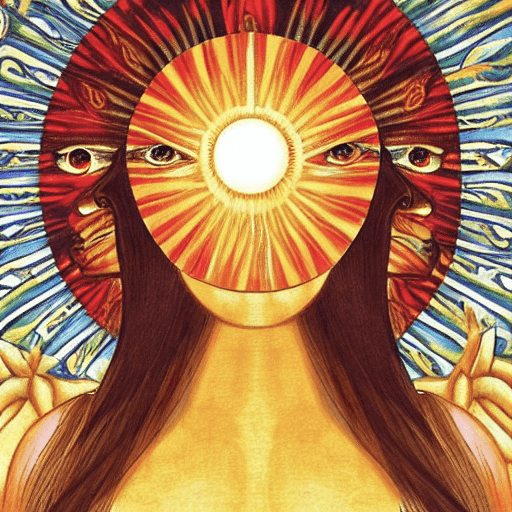
In 1962, 23-year-old French geologist Michel Sifre undertook a radical experiment, remaining in a cave 30 meters below the surface of the earth for 60 days, alone and in complete darkness save for a dim light to be able to manipulate his devices, via which he sent signals to the team who monitored the experiment. They were able to communicate with each other, but no mention was made of the passage of time. Slowly, Sifre started falling out of the natural rhythms and his intervals of sleep varied between six and 40 hours! When all 60 days were up and he finally emerged from the cave, completely disoriented, Sifre thought that only a month had passed. Ten years later he undertook a similar experiment, this time for six months. His body and mind shifted to 48-hour cycle (36 hours of wakefulness and 12 hours of sleep) and he emerged afterward with serious psychological disorders.
Every living being, from bacterias and fungus, to mammals and the creatures that survive in the deepest depths of the ocean, seems to have an “inner clock” respecting the 24-hour rhythm—the time the Earth takes to complete one axial rotation on its year-long orbit around the Sun. No living being is able to work at 100 per cent for 24 hours in a row. It is the rhythm of rest in darkness where the body restores tissues and processes important hormones, besides storing energy. Nowadays we are disrupting our circadian rhythm without concern. With the use of artificial lighting we do not sleep when the sun goes down, instead stimulating our brains with TV shows, video games, movies, and social media, most of the time munching on a snack at the same time. If not often, at least on Saturdays when you need a “rest” from the daily routine. This means we are exposed to artificial light, which is like a super-stimulant. What do we hear as a solution? “Take some pills to fall asleep.” So I ask myself, do we need to lose our lives so desperately that at some point we ask ourselves: “Who am I?”
And then we return to our origin: how entangled—if not to say how inseparable—we are, from the Sun and the Moon, the light and the darkness, from this beautiful planet of which we are little cells. We grow sick when we create artificial realities and artificial rhythms. We must not forget that we are not like the things we are creating—such as computers and machines—we are part of the five elements. From them we come from and to them we shall return. Our hearts and bodies are wild!
Where I live, as I mentioned before, on a mountain from which I can see the sun rising and setting, I can also see how much this visual pollution has interfered with the entire landscape. Ten years ago, I had to switch on a light to go to the bathroom at night; today, lights from the new houses and huge business warehouses illuminate from afar the forest and my living room—lights that I’m unable to turn off. How much madness and suffering are we imposing on all living beings with our ignorance? It tears my heart.
The rhythms of sleep and wakefulness are a kind of simulation of life and death, say Tibetan Buddhists, who have explored deepening their understanding of death and the stages after death by remaining in dark rooms or caves for extended periods, sometimes even for years! It is clear that for this experience one needs a qualified practice and a level of mind discipline that we in the West are seldom closely trained in—most likely even M. Sifre didn’t have access to such training.
Tibetan Buddhists say that our existence through eternity until we attain complete freedom is very much like that of our daily waking and sleeping stages. It is like the fractal idea that everything is the same outwardly as it is inwardly, a pattern repeating endlessly on different scales. Our nature of being awake and asleep is the same as dying and being reborn. Out of true compassion, the great tantric yogis undertook strict practices, exploring how deeply they could simulate death without losing consciousness (or their own life), and gaining wisdom about the stages of death called the bardos.
Just as in a dream, when we die, consciousness is led only by our karmic forces—very often forces of fear, anger, and desire presented by horrifying images that (just like in a dream) we believe are real. When the tantric yogis train, it is darkness itself which teaches them. If we have the discipline, the sanity, and the wisdom, we can learn more with all natural phenomena and use it to awaken virtues, to stimulate our awareness and our sense of being. Hoping that we do not have to come too often and linger too long with the question: “Who am I?”
Because it is the most obvious thing that we are not just this bag of skin; we are the universe. Let us not forget this and respect what we already are. May we not lose ourselves in the name of “civilization and technological progress,” but may we live happily, with awareness of the wisdom of this natural radiance that we already are—nature testing what works and what doesn’t work over billions of years. If we pause, watch, and listen, quietly and patiently, we will learn with Mother Nature: Her rhythm is our rhythm; Her cycles are our cycles; Her sleep is our sleep; Her progress is our progress; Her radiance is our radiance. Let us not allow the poisons of suffering and afflicted emotions to distort this understanding. Let us return to innocence.
My last words are for those of you who complain of depression, anxiety, insomnia, and other imbalances. There is so much we can do by simply taking care of our circadian rhythm, our “inner sun,” our natural radiance. I will list some suggestions to help anyone who needs support, all based on my own research and practice. These are habits that no one can do for you, but they can bring positive change if you take the time to include them in your life.
1. After sunset, dim indoor lighting to simulate firelight.
2. When sleeping, try to make the room as dark as you can.
3. Do not use electronic screens in your sleeping space, and if you must use screens at night use the “night shift” mode (a more yellowish light).
4. If possible, avoid screens and food in the two hours before bed. Use this time for reading, writing, painting, stretching, and so on. Wash the dishes and watch the sky!
5. Waking up with the sun is energy! Take in those first rays for 30 minutes (after 10am it can be too strong so watch out!)
6. Do not oversleep; up to nine hours is good enough.
7. Try to eat at the same time each day and avoid eating late.
8. Try to fast for 12 hours overnight. If your last meal is at 7pm, have breakfast at 7am. That will give your body time to restore and to burn unnecessary fat.
9. Exercise at the time that feels most suitable for your body. Some people are more receptive in the morning, some at noon. Find your best time and try to stick with it.
10. Salute the Sun and the Moon with the stars when you first see them. This little habit can bring these gods closer to your heart—and they are powerful! You might want them by your side 🙂
See more
Tiffani Gyatso
Yangchenma Arts & Music
Related features from BDG
Life Is Not Useful
Opening to Beauty
Thinking Is a Skill. But Someone Else Figured it Out Before You
Ecstasy: The Path of Joy




